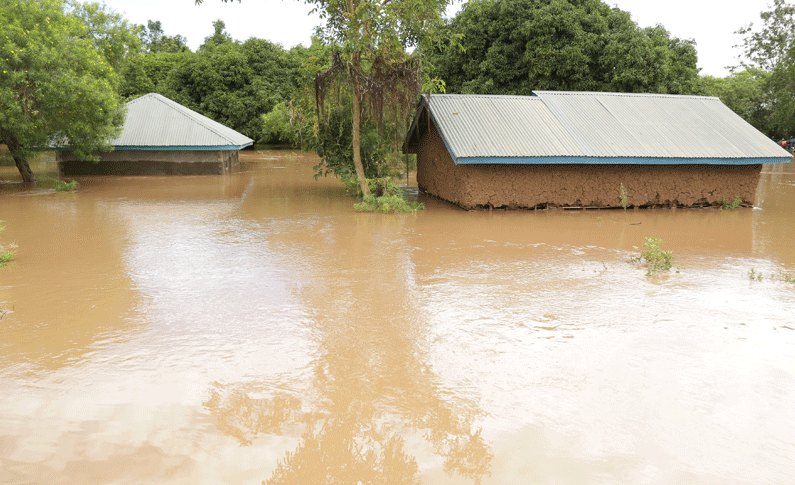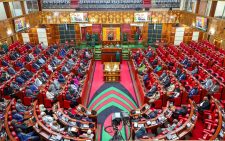New fund set to grant KSh 32.5B to mitigate against disasters

Greenhouse gas (GHG) emissions are blanketing the Earth, leading to global warming and climate change. The world is now warming faster than at any point in recorded history, with the World Meteorological Organisation (WMO) declaring 2024 the hottest year on record.
The recent devastating floods in Kinshasa, the capital of the Democratic Republic of the Congo (DRC), which left death and destruction, demonstrate the loss and damage developing countries suffer from extreme weather events.
Record levels of flooding in Africa over the past few years have compounded stress on fragile countries. Extensive flooding in 27 countries across the continent’s tropical zone experienced unusually heavy rainfall in 2024, compared to their historical norms, which mirror patterns seen elsewhere around the globe.
Global warming has intensified the debate between fossil-fuel-producing, high-emitting nations and vulnerable developing countries. It is a cruel irony that the most climate-vulnerable communities contribute the least to the climate emergency and are ill-equipped to mitigate its effects. That’s why they appealed for a loss and damage fund, a money pot to help climate-vulnerable countries front the costs of climate damages. Strong negotiations and intense lobbying saw the loss and damage fund operationalised at last year’s climate summit in Baku, Azerbaijan.
Last week, the board of the new Fund for Responding to Loss and Damage (FRLD) caused by climate change met in Bridgetown, Barbados.
After the FRLD board agreed to first focus on helping governments, rather than local communities, deal with the aftermath of climate-driven disasters like floods and droughts, the fund will hand out US$250 million (Ksh 32.5 billion) for the start-up phase of the United Nations mechanism to help developing nations tackle the consequences of climate disasters.
Scaling up
Despite pledging US$768 million to the loss and damage fund, governments have so far signed agreements for US$495 million and only paid in US$321 million. The Loss and Damage Collaboration, a network of NGOs working on the issue, told the authoritative UK-based Climate Home News digital news publication that it has estimated that developing countries’ loss and damage needs add up to about US$400 billion a year.
FRLD Executive Director Ibrahima Cheikh Diong said the secretariat would deliver a plan to attract further resources by the end of 2025. Barbados Prime Minister Mia Mottley told the board it would be necessary to “think outside of what is normal” to scale up funding.
The PM spotlighted taxes on flights, shipping and oil and gas extraction as a way to raise money for climate action.
Barbados is co-chair of the Global Solidarity Levies Task Force, together with France and Kenya, which is expected to offer concrete proposals by COP30 this November.
WMO’s declaration of 2024 as the warmest year ever recorded followed nine record-breaking years of heat over the past decade. Last year’s unprecedented temperatures fuelled heatwaves, drought, wildfires, storms and floods that killed thousands of people and displaced millions more.
Life has become dangerous with 1.3 degrees Celsius of human-induced warming, according to a recent report by the World Weather Attribution (WWA), which highlights the urgency of moving away from planet-heating fossil fuels as quickly as possible.
“Every broken record was not just a number, but accompanied by people losing their lives and livelihoods in ever hotter heatwaves and devastating floods. Yet new oil and gas fields continue to open with increase in subsidies as fossil fuel emissions reach an all-time high,” noted WWA co-lead Dr Friederike Otto.
Climate change affects the environment in many different ways, including rising temperatures, sea level rise, drought, flooding and more. These events affect things that we depend upon and value, like water, energy, transportation, wildlife, agriculture, ecosystems and human health.
Flooding caused by extensive rainfall impacted roughly 11 million people in Africa last year, resulting in an estimated 2,500 fatalities, 4 million people displaced, millions of hectares of croplands inundated, hundreds of thousands of livestock lost, and hundreds of healthcare facilities destroyed or damaged
According to this data from the Africa Centre for Strategic Studies, 10 million children in Niger, Nigeria, the DRC and Mali were unable to attend school as thousands of schools were flooded or converted into temporary housing for displaced people.
Annual precipitation data compiled by the World Bank for the nine countries that were most impacted by flooding indicates that 2024 was less an aberration and more a continuation of a pattern of increased rainfall over the past five years compared to a baseline from the previous three decades.
These grim statistics were not lost on the FRLD during its meeting in Barbados last week. The fund will spend US$250 until the end of 2026 on an initial set of interventions to help developing countries deal with the aftermath of climate-driven disasters.
The fund’s board agreed on the strategy for the start-up phase of the UN mechanism, which will initially focus on strengthening national responses to climate catastrophe rather than community-level action, as activists have called for.
Direct support
The fund will give grants of US$5 million to US$20 million to project proposals submitted by developing countries. The first round of approvals is expected at the next board meeting. Governments will also be able to obtain direct budget support for emergency measures, such as temporary housing for displaced people, in case of a disaster.
The start-up phase will be formally called the ‘Barbados Implementation Modalities’ (BIM) in a nod to the host country, says Climate Home reporter Matteo Civillini. BIM is a colloquial nickname used by Barbadians to refer to their country.
In one of the most hotly debated issues, board members decided that small island developing states (SIDS) and the world’s least developed countries (LDCs) would receive at least 50 per cent of the fund’s resources during the start-up period.
During discussions, developed countries pushed for that option, setting a minimum floor, while most developing nations wanted a less binding target that the fund would only be “aiming to achieve”. Richard Sherman, co-chair of the fund’s board, said the deal was reached after a “complicated” meeting with lots of disagreements, but the agreement showed that “collective, multilateral action was still a possibility”, wrote Civillini.
Among the most contentious issues was the role of other multilateral funds, such as the Green Climate Fund, in delivering the projects and the provision of financial instruments apart from grants, such as a blend of public and private finance.
On the first point, the board decided the start-up phase may be implemented in collaboration with other entities and tasked the FRLD’s Secretariat with devising a proposal. On the second issue, the fund will only disburse grants but recipient countries can voluntarily decide to combine them with other instruments.
Climate Home said Harjeet Singh, founding director of the India-based Satat Sampada Climate Foundation, welcomed the board’s decision as a “long-overdue step in supporting countries devastated by climate impact”.
He added however that frontline communities must not just receive support, they must have direct access to resources and decision-making over rebuilding their lives. The money at the fund’s disposal is dwarfed by the escalating costs of dealing with the consequences of climate impacts.













